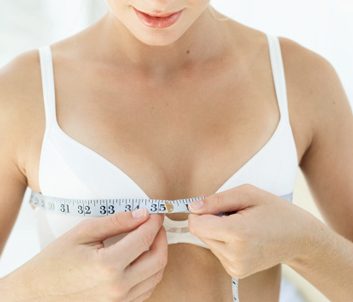
Should you get a breast reduction?
Colossal cans, humongous hooters, tatas ’til Tuesday… Suzann Paterson, 46, has heard it all. The married mother of two from Oakville, Ont., has always found such euphemisms somewhat offensive, but tries to see them as silly-worthy of an eye-roll, say, versus an icy glare. She’s happy those days are behind her and the comments are no longer being directed at her.
Suzann hails from a long line of large-breasted women. “All of the women on my mom’s side are large breasted. In fact, we jokingly call it the family curse. But for me, it wasn’t funny. I hated having big boobs, and by the time I was in my mid-20s I couldn’t stand it anymore.” So just over 20 years ago, she had a breast reduction-and it changed her life.
For those who wish their breasts were bigger, it may be hard to wrap your head around why a woman would want to go down in size. After all, aren’t big breasts attractive? Wouldn’t it be nice to have an attribute that sets you apart? Wouldn’t you secretly enjoy showing up at pool parties and watching the faces of other females fall? No, no, no, says Suzann. It is utter hell.
For one thing, Suzann has always been fairly petite. She describes herself in middle school as an athletic, happy-go-lucky tomboy who, at five foot four, wore a size 2. But then, when she was 14, she went from a training bra to a 34D seemingly overnight. “It happened so fast,” she recalls. “And because I stayed small everywhere else, my breasts really stuck out. I remember they felt foreign, like extra appendages. Running really hurt, and I was so embarrassed by the way they flopped around that I quit sports.”
As Suzann’s breasts continued to grow, her self-esteem diminished. She became shy and self-conscious. To hide her body, she wore baggy clothes. Throughout high school, she had female friends, but rarely went on dates. “I didn’t want to be touched sexually, so I pretty much stayed away from boys.”
By the time Suzann was in university, her breasts-36E by then-were starting to take a toll on her physically as well. She experienced neck and back pain, and the pressure of her bra straps left grooves in her shoulders.
One day, she decided she’d had enough. Her family doctor gave her the names of a few plastic surgeons and after doing some research, she settled on the one she felt most comfortable with. “By this point I had a boyfriend, who is now my husband. I told him I was going to have the surgery; he didn’t think there was anything wrong with my breasts but he knew how much they bothered me, so he supported my decision.” And how did he feel afterwards? “There were no complaints,” she says. “That’s for sure.”

Understanding the risks
Still, Khanna (who did not perform Suzann’s operation) warns that a change in nipple sensation is a risk. “Your nipples could end up more sensitive or less sensitive, or one may be more sensitive than the other.”
As well, some women who have had the surgery and later have children could find it difficult-or impossible-to breastfeed because the number of working milk ducts may be decreased. “There is no guarantee that a woman will be able to breastfeed, so I always make sure prospective patients understand that,” says Khanna. “If they are unwilling to accept the risk, I suggest they wait to have the procedure until after they’ve had kids.”
As with any surgery, there are immediate risks relating to the procedure itself and the anesthetic. Problems during the early recovery period can include infection, fluid collection and a compromise of blood supply to the nipple. In later recovery, asymmetry issues may arise (that is, there may be a difference in the appearance and size of each breast). And the surgery does leave scars; these will usually fade but the degree to which they do depends on time, the patient’s skin and other health factors.
Despite such risks, Khanna says that in the two decades she’s been in practice, the procedure has seen many improvements. Aesthetically, the results are superior since surgeons may now use liposuction to remove additional breast fat and refine the breast’s shape (the costs associated with liposuction are not covered by provincial health plans, except in Quebec, where it is covered if deemed medically necessary by your specialist). As well, the amount of time spent in hospital has been significantly reduced. Twenty-five years ago, all patients were given a blood transfusion. This meant a woman not only had to incur the risks associated with a transfusion, but also had to be admitted a few days prior to the operation for blood work. About 20 years ago, transfusions were deemed unnecessary, so today a breast reduction is usually a day surgery. Although heavy lifting or heavy work is not recommended for up to six weeks, women with, say, a desk job are generally back to work within two weeks.
No matter how much the surgery has improved, though, one of Suzann’s three sisters, Kathy, 30, isn’t interested in it unless it becomes necessary. She has always been happy with her large breasts-until recently, a size 36DD-which have never really bothered her. But having had her first child last July, Kathy now fills an F cup. And given her family history, she figures she’ll end up with bigger breasts in the future. Would she have a reduction? “I want to be sure I’ll be able to breastfeed and I plan to have more children, so I’m not going to worry about it for another eight years. But yes, if by then my breasts are big and droopy, if it’s affecting my health and lifestyle, and if I don’t feel confident when I look in the mirror, I will have the surgery.”
Interestingly, another sister of Suzann’s, Gail, 35, had two breast lifts when she was in her 20s. The elective procedure is similar to a breast reduction in that the nipple and areola are raised, but the breast’s size is not reduced. “For me, it was vanity,” Gail admits. “My breasts are medium sized, but I was single and I wanted them to be higher and perkier.” Gail is not happy with the results of her surgery, but for legal reasons she can’t discuss it.

The procedure
Breast reduction, or reduction mammoplasty as it is technically called, is performed under a general anesthetic; it reduces the size and weight of the breasts, and refines their shape. According to the Canadian Institute for Health Information, breast reductions were performed on 12,684 women in Canada in the fiscal year 2011-2012, about 1,000 more than in the two previous fiscal years. The procedure is covered by all provincial health plans, but only if the candidate’s breast size is creating detrimental physical and/or psychological health issues for her. The criteria differ depending on the province. In Ontario, for example, the patient must be experiencing physical problems such as neck, back or shoulder pain; there must be a significant disproportion in the size; and a doctor’s referral is necessary (approval for that province’s funding must be sought by the surgeon before the procedure). If you do not qualify for coverage, the price of the procedure varies from surgeon to surgeon (for example, Dr. Julie Khanna, a plastic surgeon in Oakville, Ont., who was interviewed for this story, charges anywhere from $6,000 to $8,000).
Here’s how it’s done: The traditional method, known as the “inverted T” or “anchor” technique (which is what Suzann had), involves three incisions: one around the nipple’s areola; another straight down from the bottom edge of the areola to the breast crease; and a third, U-shaped incision following the curve of the breast’s underside. (These days surgeons now also offer a newer technique called the vertical incision, which omits the third cut.)

During the surgical procedure, unwanted breast tissue, fat and some skin are removed. Plus, the areolae-which surgeons can also make smaller-and nipples are moved higher. In most cases, and with both types of surgery, the areolae and nipples remain tethered to blood and nerve supplies during the operation, in order to preserve as much sensation as possible.

Breasts and body image
As Khanna points out, breasts are unique in that they are an outward expression of our femininity. Whereas our other “lady bits” are covered up, breasts, although cloaked, are highly visible, and as such get the attention of males-whether wanted or not.
Oddly, they also get the attention of other females. A common complaint of large-breasted women is that people-regardless of gender-stare at their chest, and don’t look them in the eye. Some believe their large breasts are downright alienating.
“One day, a mother and her 14-year-old daughter came to see me about a breast reduction for the girl,” Khanna says. “I advised them to wait until after she was finished developing because otherwise she might end up having to have the procedure done again in the future. When I told them no, both the mom and daughter burst into tears. The girl was already a double-F. The boys wouldn’t talk to her and neither would the girls. I did the procedure.”
Andrea McTague, director of Lifeworks Psychology and a registered provisional psychologist in Edmonton who specializes in body image, says breasts are highly sexualized in our society, and therefore generally play a large role in a woman’s body image regardless of her age. “Studies show that younger women focus on the size of the breast, whereas older women worry more about the quality, such as whether they droop,” says McTague. Not surprisingly, risk of the dreaded droop increases after pregnancy, especially if a woman breastfeeds.
Generally, negative body image issues develop when there is a discrepancy between what you think the “ideal” body should be and what your own body looks like. “The greater the discrepancy,” says McTague, “the greater the risk of developing negative feelings.”
Where does our perception of “ideal” come from? According to McTague, research shows there is no “right” breast size, according to both men and women. But a woman’s perception of what is ideal is influenced by a variety of factors such as family, friends, the environment they live in, the media, and even the era.
Suzann’s mother, Sandra, 66, remembers worrying about Suzann throughout her daughter’s teenage years. “When her breasts got so big, I felt sorry for her. I thought, oh boy, what does she have in store?”
Sandra, like Suzann, is petite with very large breasts and had a hard time in high school. Kids called her names such as Floppy Sandra, boys chased her, and she wasn’t able to wear fashionable clothes. “I became really self-conscious. I always wore big T-shirts so they wouldn’t stick out. Today, because bras now offer better support, I don’t have problems finding clothes that fit, except for button-down shirts.”
Sandra says she wouldn’t consider a reduction at her age but would have, if she could have, back in the day. She’s grateful, however, that Suzann had the opportunity. “She was so happy after she had it done,” Sandra recalls. “She was like a different person.”
Despite the scars, which Suzann says are hardly noticeable now, and a slight loss of nipple sensitivity (she was able to nurse both of her children after surgery), she has no regrets. “I became a new woman,” she says. “And yet the real me.”
Related:
• Your guide to healthy breasts
• Why women get Brazilians
• 9 new bra finds
